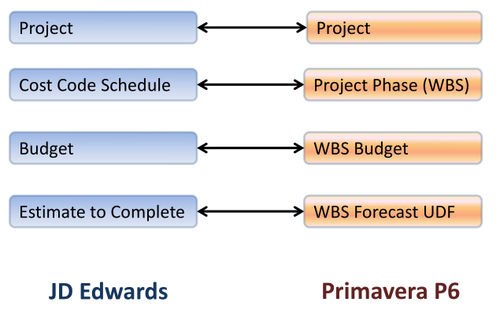JD Edwards is widely used in a number of industries, including manufacturing, distribution, and asset-intensive industries. It is in these asset-intensive industries where capital projects are a major concern that P6 and JDE meet.
The standard integrations from Oracle are based on a Process Integration Pack. In order to use the PIP, it and the underlying technology must be purchased and installed separately from the JDE install. JD Edwards has two main code branches: EnterpriseOne and World. The integrations work with EnterpriseOne, not with World, and with EnterpriseOne versions 9.0 and above.
The integration points between JDE and P6 can be broken into two components, global data and project data. As you will see, this pattern is true with EBS and PeopleSoft as well.
Global data exchanged between P6 and JDE is oriented around the management of resources. Resources in P6 can tie to three different entities in JDE:
- Assets in JDE map into non-labor resources in P6
- Materials in JDE map into material resources in P6
- Address Book employees in JDE map into labor resources in P6
In JDE, assets can be managed from a number of modules, including Capital Asset Management and Service Management. No matter which JDE modules are used to manage the assets, the integration pulls equipment data from the F1201 family of tables and rates from the F1301 family of tables.
Materials in JDE are managed through a number of modules such as Materials Management. The integration pulls materials from the F4101 family of tables and the item rates from F4106.
In JD Edwards, all individuals and corporations are stored in the address book, which revolves around the F0101 set of tables. Items in the address book include suppliers, customers, and subcontractors, as well as employees. These entities can be pulled into P6 as global labor resources.
Global roles from JDE are stored in the job tasks table F08001. These roles are brought into P6 as global roles.
Calendars from the F13 system of JDE are brought in as global calendars.
The supplemental job table F5109 brings JDE chart types into P6 as WBS Project Phase categories.
In all of this, JDE is considered the master of the data. Changes in JDE will flow into P6, but changes in P6 are not sent back into JDE. For this reason, these global resources should not be altered in P6.

Project-level data exchanged between JDE and P6 is oriented around synchronizing budgets, forecasts, and dates at the WBS level.
Projects may originate in either P6 or in JDE. In practice, it is best to choose one system or the other as the origination point of projects.
When a project originates in JDE and is sent into P6, the JDE chart of accounts (F0901) and cost code schedule (F51901) are used to create top-level WBS elements in the P6 project, which correspond to the project phase. Account balances and forecasts are brought into these same WBS elements from the JDE account balances table, F0902. When a project originates in P6 and is sent to JDE, the reverse of this process happens.

As the project is scheduled in P6, the dates at the WBS level are updated. These dates then flow back into JDE on the Cost Code Schedule.
